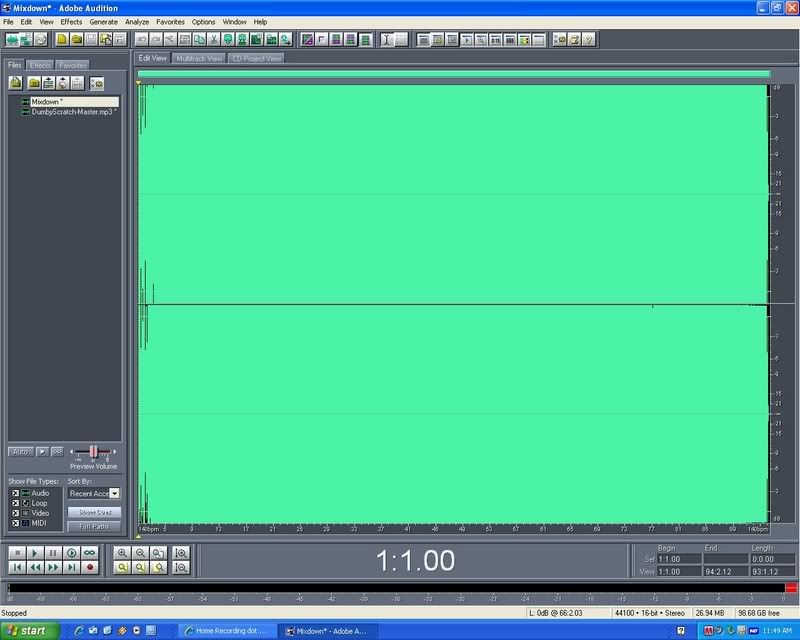Best advice I've got is, without using ANY plugins/effects/etc., get your mix sounding as good as you can without doing anything but setting levels. Don't even mess with panning yet. Your mix will sound crowded, but it will at least get you an idea of where you stand. Once you've got it sounding the best you can with just faders, add panning into the mix (I don't even know if that counts as a pun as I imagine it might actually be referring to the origin of the term!). Get it sounding the best you can with just faders and panning.
Once you've got it absolutely the best you can with faders/panning, listen to which tracks conflict with each-other, whether sonically or content-wise (two busy guitar parts for instance), and start to think of whether you want to cut out one of the conflicting tracks, pan it a different direction, or try to make it work with some conservative EQ. Also take note of parts that at some places seem to jump out, and at others are too quiet. These tracks will most likely need either some volume automation (which doesn't introduce artifacts or color the sound), or compression (which typically introduces artifacts and colors the sound depending on the compressor you use, the settings you use, and what affect/effect you're going for.)
Both compression and EQ can be your best friend, or your worst nightmare. Just like a hammer or chisel, they're the perfect tools to craft beautiful art, yet are also the perfect tools to destroy beautiful art beyond recognition.
With EQ's, the most important thing to drill into your head is that your first instinct should be to take away shitty frequencies, vs. boosting sweet ones. Most EQ's are not transparent, and all EQ's are different. If you take two different EQ's (either plugins or hardware, more so with hardware) and cut the exact same frequency by the exact same amount (according to the EQ), they will sound different. This becomes much more apparent when you start boosting frequencies, which is why you generally want to cut before boosting as you most likely don't know right off the bat what your EQ(s) sound(s) like. Cut before you boost.
So what do you cut? Easy: stuff that sounds like shit! Haha, if only it were so simple. There are a few general rules that more often than not end up being true. For one, many instruments have frequencies that aren't generally considered appealing (such as the cardboard-y sounding frequencies in drums, or the muddy low frequencies in distorted guitars) and can generally be cut in varying amounts. HOWEVER, until you've mixed many, many songs, you really shouldn't start cutting shit because you've BEEN TOLD to. Cut stuff that sounds bad, or that conflicts with other instruments, not what LOOKS right. Only cut if you HEAR the problem. Don't use your eyes. Your eyes can't hear shit, and music is sound, so by definition your eyes can't see music. Ask a deaf person to tell you what a song sounds like based on how it looks. They'll most likely be very angry and might even punch you in the junk for asking them to do something so stupid, and you'd deserve it. MIX WITH YOUR EARS! I typically close my eyes, or turn off the monitor (which works really well) and just listen for stuff that sounds bad. Then I open my eyes/turn on the monitor and fix what I hear. Then turn the monitor back off. Wash, rinse, repeat.
Compression is a whole other "can o' wormies" (props to slipperman haha) that deserves, and has, it's own thread/s. Long story short, don't compress just 'cause you think you should, and remember it's an effect. Use wisely.
When it comes to other effects like Delay/Reverb/Chorus/Stereo Widening/Limiting (similar to compression)/expansion (kind of like inverse-compression)/Multiband Compressing (an incredibly versatile tool, and one that's very very hard to use)/etc., work on getting your mixes sounding absolutely fantastic BEFORE effects. Effects aren't crutches, they're seasoning. A burnt chunk of dog shit won't ever taste like steak, no matter how much salt you put on it. Get the best-sounding tracks you can right from the start. There's no "New Strings on your Guitar" frequency on any EQ in the world. Practice ain't a knob. Etc. etc. etc., just get it sounding killer in the room before picking up a damn mic. If it doesn't sound killer, don't record it!
Anyway, I'm still nowhere near as good at mixing as many of the people on this site, but this advice (much of which was gleaned from this very bbs!) is sound (ha ha ha) and has helped me improve my mixes quite a bit! Especially the eyes vs. ears bit.
Hope this helps!
 order of doing things when mixing --- i mean : first you do the graphic eq,then parametric,move on to compressing things...etc.
order of doing things when mixing --- i mean : first you do the graphic eq,then parametric,move on to compressing things...etc. order of doing things when mixing --- i mean : first you do the graphic eq,then parametric,move on to compressing things...etc.
order of doing things when mixing --- i mean : first you do the graphic eq,then parametric,move on to compressing things...etc.
 then I turn them some more
then I turn them some more 

